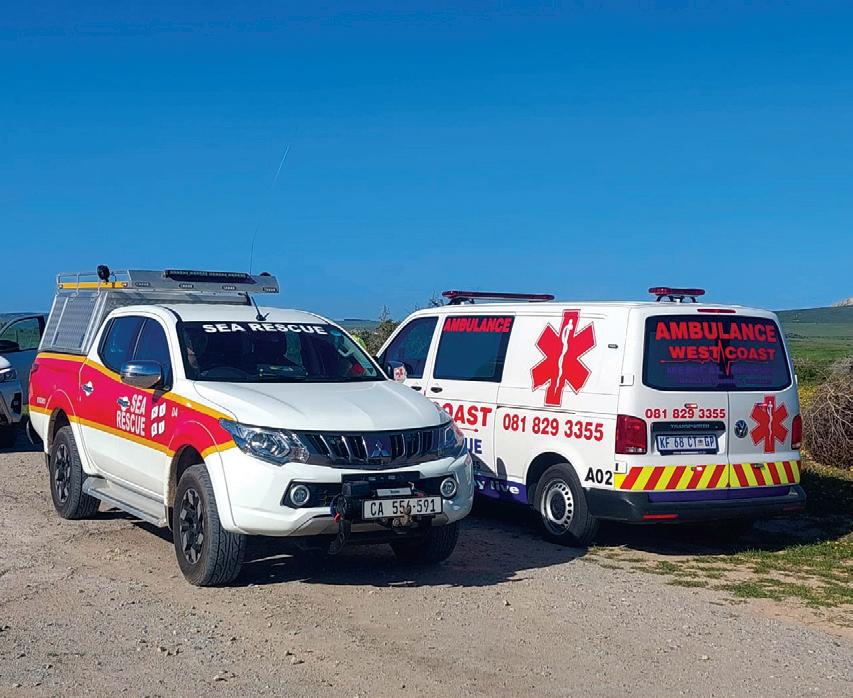
5 minute read
LOST AND FOUND
When a kayaker was reported missing off the frigid waters of Paternoster on the Cape West Coast, Station 4 (Mykonos) mobilised immediately. Rob Mousley tells the story.
BY THE TIME THE paddler crawled onshore, he’d been in the cold Atlantic Ocean for nearly an hour and he was in a very serious condition. ‘He was way beyond shivering,’ says Station 4 (Mykonos) station commander Nic Stevens. ‘If we’d got there even 30 minutes later, the story might have ended very differently.’
The 69-year-old man had launched from Paternoster’s main beach at 10am on 6 September, in a plastic roto-molded holiday kayak. It was a sunny spring day and he’d stripped off to his beach shorts to enjoy the weather while he paddled in the sheltered waters of the bay.
Friends saw him going out and thought nothing more of it…
The first time anyone realised something was wrong was at lunchtime, nearly three hours later. After searching the beach and frantically scanning the sea, someone suggested calling the NSRI and that was when the Mykonos crew were activated.
The team assembled, rapidly hitched the rescue craft Spirit of Rotary East London II to their 4x4 and set off for Paternoster, some 40 minutes up the coast.
As they drove, they discussed what might have happened. The lone kayaker had possibly been blown north from the beach by a fresh southeaster, and if he’d gone beyond the sheltered water near the beach, he’d be fighting very rough sea conditions, with ocean swells of 3 metres.
The best-case scenario was that the paddler had managed to stay near the shore, but with the wind blowing from the southeast, he could have been blown out to sea. And 7km north of Paternoster, a rocky reef extends nearly 3km out from the shore and on a day like this, the whole area would be a maelstrom of violently breaking waves. If by some miracle the paddler survived that, he’d be heading out into the open ocean as the coastline curves east at that point. The possibility of finding a tiny craft in the open Atlantic? It doesn’t bear thinking about. And the cold was a huge concern too.
The average water temperature in Paternoster in September is around 14°C and someone in the water wouldn’t last long before succumbing to the cold.
The NSRI crew prepared to launch from the Paternoster beach. Having considered the currents, the wind, and the waves, they planned to start their search some way up the coast towards the Groot Paternoster Point. Observers on shore would scan the sea using binoculars.
Then another call came in, this time from some visitors staying at the Groot Paternoster Private Nature Reserve. A man had been found on the shore, and he appeared to be injured.
Now the challenge was how to move the casualty from the beach, miles from any road, to the ambulance. The NSRI 4x4 crew started off down a very rough beach track, making their way over sand and rocky outcrops north towards the nature reserve. The journey, a frustrating balance between speed and caution, seemed to take forever.
Sure enough, it was their man. He’d been blown out to sea and had eventually capsized behind the backline, some 5km up the coast from Paternoster Beach. Unable to climb back onto the kayak, he’d spent nearly an hour in the frigid water before finally managing to swim to shore. He’d been spotted by the holiday makers at the nature reserve, and they’d done the best they could to wrap him in jackets after calling the NSRI.
Relieved that they weren’t dealing with two separate incidents, the rescue crew swung into action. While not actually injured, it was obvious that the casualty was severely hypothermic and their top priority was to warm him up. Wrapping him in a foil blanket, the NSRI crew loaded him into their vehicle and set off back down the bumpy track to the ambulance.
‘His core temperature was way down,’ says Nic. ‘When they got him to hospital, they put him in a heated bed bag and onto a drip.
‘But he was lucky,’ Nic adds. ‘His temperature was almost at the point of no return.
‘We’d like to thank the bystanders who spotted the casualty; without them we might not have got to the scene in time.’
The NSRI urges kayakers and other seafarers to take adequate precautions even when conditions seem mild. Conditions near to shore can be deceptive, especially when the wind is blowing offshore. Kayakers should always wear a lifejacket and should consider other safety devices such as body and paddle leashes.
In particular, the NSRI recommends the use of SafeTrx, a free-to-use tracker app that can be installed on any smartphone. SafeTrx is monitored 24/7 by the NSRI Emergency Operations Centre and has been critical in many rescues around the world. SafeTrx takes the ‘search’ out of search and rescue.

▶ Go to www.nsri.org.za/water-safety/ safetrx/ for more information.








